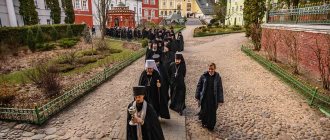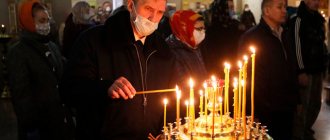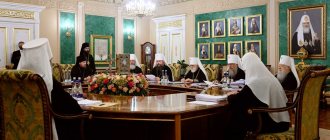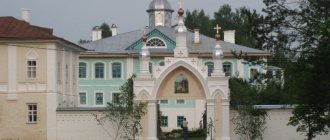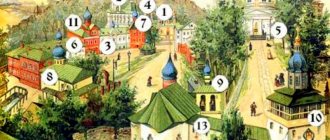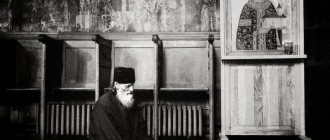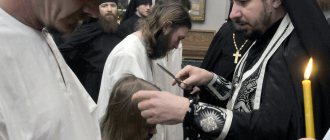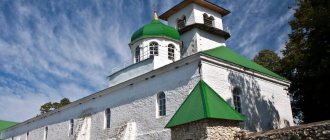Story
Initially, the abbot was not necessarily a priest; later they began to be elected only from among the hieromonks or to ordain a monk chosen by the abbot as a presbyter.
In 1764, during the secularization reform, Russian monasteries were divided into three classes; the head of the monastery of the third, lower class began to be called abbot. The difference between him and the archimandrite (the abbot of a monastery of the first or second class) was that during divine services he dresses in a simple monastic robe and gait, while the archimandrite dresses in a mantle with “tablets”, a pectoral cross, a club and a miter[2].
There were orphanages at Orthodox monasteries, whose children received the surname Igumenov (Igumnov). This surname originates from the patronage of the abbot of the monastery over orphans, children of fallen heroes of the Fatherland, who had a safe conduct letter from the abbot. They were called inviolable, abbots.
Due to the fact that the total number of monasteries was greatly reduced, the rank of abbot became a reward for the monastic clergy (the rank corresponded to an archpriest in the white clergy) and was not necessarily associated with the management of the monastery. This practice was consolidated in the 20th century, when after the revolution all monasteries in the USSR were closed, and after the Great Patriotic War a small number of them operated. Only the abbot, who was the head of the monastery, had the right to carry a staff.
In 2011, the Council of Bishops of the Russian Orthodox Church, having accepted the proposal of Patriarch Kirill, henceforth abolished the rank of abbot as a hierarchical award and decided to ordain not only hieromonks, but also archimandrites and even bishops as abbots if they take over the management of the monastery[3]. Simultaneously with the rank of abbot, the staff must be presented. When leaving the position of abbot (vicar) of the monastery, the title of hegumen will be retained by the person in memory of the labors incurred. The rite of installation as abbot is contained in the “Official”[4]. Those who were awarded the rank of abbot before 2011 and who are not abbots of monasteries, this title was retained. According to Bishop Savva (Tutunov): “Now all leaders of monasteries and only them are called abbots. There are still a number of priests who were called abbots in the pre-reform period, but this is a disappearing type of award title”[5].
What does the abbot do?
Who is responsible for the entire monastery and for each monk? This is the abbot. He exercises disciplinary supervision over the monks. For each of the monastics, the abbot must be a loving father and a strict teacher. By his example, he shows the brethren of the monastery how to live a real monastic life.
In addition to taking care of the brethren, the abbot has administrative responsibility. It is he who interacts with government authorities and is the representative of the monastery. The abbot is the link between the monastery and the world. Combining administrative and spiritual activities is not at all easy. And inside the monastery, the abbot must keep up everywhere. Monastic obediences are coordinated with him, and responsibility for the economic part falls on his shoulders (less often on the abbot’s assistant, the dean). All expenses of the monastery go through the abbot, all donations too. He decides what will be served to the monks at the meal, what needs to be repaired in the monastery, and how to welcome the monastery’s honored guests. In general, Father Abbot carries all the worries on his shoulders.
Notes
- Bishops' Council of the Russian Orthodox Church 2021. Regulations on monasteries and monastics
- Barsov N.I.
Hegumen, abbot of the monastery // Encyclopedic Dictionary of Brockhaus and Efron: in 86 volumes (82 volumes and 4 additional). - St. Petersburg, 1890-1907. - Regulations on liturgical and hierarchical awards of the Russian Orthodox Church (2011).
- Bishop's official. Book 1. Rin performed at the work of an ignoramus
- Archimandrite Savva Tutunov: I do the same thing in the Church that I did in science // vesti.ru, April 11, 2018
Literature
- Barsov N.I.
Igumen // Encyclopedic Dictionary of Brockhaus and Efron: in 86 volumes (82 volumes and 4 additional). - St. Petersburg, 1894. - T. XIIa. — P. 794. - Hegumen / Bondach A. G. // Iron tree - Radiation [Electronic resource]. - 2008. - P. 691. - (Big Russian Encyclopedia: [in 35 volumes] / chief editor Yu. S. Osipov; 2004-2017, vol. 10). — ISBN 978-5-85270-341-5.
- Litvinova L.V.
Hegumen // Orthodox Encyclopedia. - M.: Church-Scientific, 2009. - T. XXI: “Iveron Icon of the Mother of God - Ikimatariy.” — P. 168-172. — 752 p. — 39,000 copies. — ISBN 978-5-89572-038-7.
Abbess and princess. Mother Tamara on Olivet
Part 1
Part 2
III.1. The first years of bearing the abbot's cross
The year 1951 was marked for nun Tamara with her “ascent” to the top of the holy Mount of Olives and the beginning of carrying the abbot’s cross there. In the wonderful and sweet sound of the word “Oleon” she felt some amazing combination of mercy and oil. Since her adolescence, she knew about the mention in the Holy Scriptures of the “Mount of Olives” (Mount of Olives). Many Christian places associated with important events in the life of the Savior are concentrated here. The name of the mountain itself is first found in the prophet Zechariah; it was the place where King David worshiped God (2 Sam. 15:30-32). Ezekiel, in his prophecy about the end of days, gives Olivet a special place: “And the glory of the Lord arose from the midst of the city and stood upon the mountain that was east of the city” (Ezekiel 11:23). Jesus Christ “spent his nights on the Mount of Olives” (Luke 21). Here He preached a sermon (Matthew 24; Mark 13; Luke 21) and prayed before his arrest (Luke 22). The Mount of Olives was the site of the Ascension of the Savior. Nun Tamara, in her youth, read that a Russian monastery was being built on the southern peak of this mountain, near an Arab village. However, then she did not even imagine that she would leave worldly life, take monastic vows and become the abbess of this Russian monastery for more than twenty years. Having moved to the Mount of Olives in 1951, nun Tamara for some time served as the “deputy” of Schema-Abbesses Antonia (Klyueva; 1881 or 1883 - 1963), who was preparing to retire. The nun, according to the decision of the Synod of the ROCOR, was supposed to replace Schema-Abbess Antonia, who before accepting the schema was called Abbess Pavla. This “most worthy old woman, full of spiritual experience and divine wisdom,” led the monastery twice - in 1929-1934 and in 1944-1951, and by the time nun Tamara arrived at the monastery, schema-abbess Antonia had already been retired for ten years. By the definition of the Synod of the ROCOR dated July 31 / August 13 of the same year, Mother Tamara became the new abbess of the Holy Ascension Monastery, which was then administratively located on the territory of the Arab village of At-Tur (from the Aramaic name of the Mount of Olives - Tura-eita) in Transjordan, which was then part of Kingdom of Jordan. However, during the six-day war in 1967, Jordan lost control over the entire Mount of Olives and it, together with the Holy Ascension Convent, completely came under Israeli control.
…Nun Tamara officially took charge of monastic life at the Olivet Monastery on September 14, 1951, the day of the church’s new anniversary. The head of the Russian spiritual mission, Archimandrite Dimitri, who became mother’s spiritual father, leader and support for the rest of her life, in the presence of 127 sisters, pronounced “a heartfelt word to the new abbess.” He wished the new abbess that the Russian convent she headed and all its nuns would become “faithful guardians of the heritage of the Russian Church in the Holy Land.” There are memories that from this first day, without the blessing of Archimandrite Demetrius, Abbess Tamara never independently began to decide and implement any business in the monastery: be it minor repair work in the monastery or sending correspondence. In the early 50s, the Olivet Convent was the largest convent in Russia Abroad: more than 120 nuns labored in it, and the vast majority of them were elderly people. At the end of World War II, an influx of refugee women from European displaced persons camps, as well as refugees from Bessarabia, poured into the Holy Land. Refugees from Bessarabia, occupied in 1941 by German-Romanian troops, and again occupied by the Red Army in March - August 1944, managed to get to the Olivet site. These refugees partially joined the monastery, where they became laborers or novices. In economic terms, the situation of the Monastery of Olives was very deplorable: there was no help from Russia, from Russian emigrants and pilgrims. All the Olivet sisters lived very, very poorly. The International Red Cross, taking into account the plight of the Russian monastery, took it under temporary guardianship. There were only “ten Jordanian piastres” in the monastery treasury, and only one American dollar was then 35 Jordanian piastres. Abbess Tamara had to take some urgent measures. On difficult days, she recalled the words of Metropolitan Anastasy, who had tonsured her as a nun, once spoken to her: “Your name will help the cause of helping the monastery...” Mother wrote in the evenings and the next day sent letters to all her relatives and acquaintances with a request for “all possible participation in the formation of the monastery " At the very beginning of the 50s, a letter from a certain pilgrim was distributed in many ROCOR parishes in European countries, in which she presented a brief historical overview of the monasteries in the Holy Land, including the Olivet monastery. The same letter outlined the problems and needs of the Monastery of Olives. It can be assumed that this “pilgrim” was Abbess Tamara herself (?). Her new novices also sent letters to their friends and acquaintances in France, Germany and England about the shrines of the Mount of Olives and asked to disseminate information among the Russian Orthodox emigration about the plight of the nuns and members of the Russian Spiritual Mission of the ROCOR. Bishop Seraphim (Ivanov), who in the fall of 1952 made a pilgrimage from the United States to the Holy Earth. “... Mother Abbess Tamara had a lot of worries,” wrote the bishop. “The urgent task is to repair at least two more water tanks, and there were about a dozen of them in the monastery at that time. The 1927 earthquake damaged all the tanks, and since then only two have been repaired. Abbess Tamara managed to repair one small tank for several hundred dollars, but even three tanks are clearly not enough for the monastery. In the hospice building and in many of the monastic cells, the roofs leaked in winter. Some nuns had to sleep in their cells under an umbrella during heavy rains. Mother Tamara urgently had to find a large sum of money to repair the roof of the bell tower. The ceiling of the refectory church had collapsed, and the tanks needed to be thoroughly repaired to collect rainwater in the winter. The water, valuable at Olivet, was distributed once a week to all the sisters, one bucket for drinking and the same amount for household needs” [1]. In addition, several monastery buildings fell into disrepair and in some places on the territory of the monastery a stone fence collapsed, and money was urgently borrowed from “one lady” for repairs. The Olivet Convent at that time was not yet a dormitory. The sisters each lived on their own and took care of their own food. From the treasury of the Russian Spiritual Mission they received only $1.25 a month for their needs, as well as some flour and various products. Young nuns went to Jerusalem to earn extra money, but the old and sick had “very hard times.” Some sisters worked on the construction of the road towards Jericho. Many nuns, for various reasons, could not earn money on their own. The elderly and elderly nuns did not have a primus stove in their cells, or even a tablecloth on their meager table. The sick sisters lay on their beds and were covered with some kind of rag. Mother Tamara took special care of the sick: a bowl of soup was brought to them every day from the abbot’s room. In addition, she instructed “their cell neighbors to carry out an inspection and take all possible care of the weak and sick sisters.” Somewhat later, the abbess opened a small hospital in one of the monastery buildings - a “hospital”, as the sisters called it. In the 60s, Sister Olga, who was experienced in medicine (in her monastic vows, Sister Martha), who arrived at Olivet from Paris, diligently carried out her obedience here. Thanks to the mother’s care, the icon-painting and gold-embroidery workshops were reopened, accepting orders for painting icons and making mitres, vestments, shrouds, airs and shrouds, banners and other church items [2]. According to the recollections of contemporaries, talented needlewomen worked here in those years: nuns Tryphena, Matrona and others. “No one abroad can make a miter or embroider a shroud better than them. One of the best ways to help Eleon is to place orders from his gold embroidery workshop through Mother Abbess Tamara,” wrote Bishop Seraphim [3]. The first years of the reign of Mother Superior Tamara coincided with the same difficulties that the head of the Russian Ecclesiastical Mission, Archimandrite Dimitri, experienced, sharing with his mother about his ever-increasing problems. Abbess Tamara not only empathized, but also sought to help her spiritual mentor and friend in every possible way. Forced and in agreement with the abbess, several expelled brothers from the main building of the Russian Ecclesiastical Mission also came under the wing of the convent, which had free premises and cells after the war. Among them was Archdeacon Methodius (Popovich), who later became a clergyman and confessor at the monastery. The presence of free premises in the monastery became the basis for the fact that the Olivet Monastery also became the seat of the head of the Mission, Archimandrite Demetrius. He moved to the holy mountain after his appointment as head of the Mission, and this event took place on the eve of the Christmas holidays in 1952. The subject of Archimandrite Dimitri's concerns was the personnel of monasteries and farmsteads in Palestine, numbering up to 200 people. In addition, he was the dean of Russian churches in Beirut, Tehran and Egypt. Archimandrite Aristoclius (Gromyko; 1887 - June 1, 1967), who had been a member of the Mission since 1919, served for some time in Alexandria. According to nun Marina (Chertkov), before his temporary ministry in Egypt, he carried out obedience in Jaffa, at the Tiberdias orphanage. Upon his return from Alexandria, Archimandrite Aristoclius served as the sacristan of the Russian Ecclesiastical Mission in the jurisdiction of the ROCOR and was the confessor of the Olivet Convent. Father Aristoclius was greatly respected by Archimandrite Demetrius and Abbess Tamara. Archimandrite Demetrius’s first assistant as the head of the Mission was his secretary, a very educated Arab nun Magdalene (Kafati), who had “pre-war Russian training” and spoke several foreign languages, so necessary in Palestine. After the Mission's headquarters officially opened at the Monastery of Olives, a white iron cross appeared above the massive and tall iron gates of the main entrance facing the Old City of Jerusalem. The Arab population of the village of At-Tur saw on the gate a twisted design made of iron rods with metal letters that made up the inscription “Russian Spiritual Mission”. Nuns of Arab origin explained to curious residents what the text of this original sign meant. Father Dimitri received from Mother Tamara a study and a cell in the two-story “House of the Head of the Russian Ecclesiastical Mission,” located at the eastern end of the monastery territory and called by the Olivet sisters the “former house of Kadysheva” (a philanthropist. - Author’s note) or the “archimandrite’s house.” The lower floor of this building housed a museum of antiquities, and the floor of the house chapel was decorated with 9th-century mosaics with images of fish, birds and various ornaments. With the assistance of Mother Tamara, a garage was gradually built near the building for the “mission car”, which was so necessary then for both the head and ordinary members of the Mission. The Head of the Mission, Father Demetrius, periodically traveled to Jericho, to Hebron - to the metochion in honor of the Holy Forefathers and to the Judean Desert. Here, in Wadi Kelt, the monastery of St. Chariton the Confessor, which belonged to the Monastery of Olives, was founded, popularly called the “Faran Lavra”, where for more than 20 years the elder monk Gerasim (died on August 17, 1957) was its guardian. Monk Khariton also labored here (he died on September 8, 1952). These monks are buried in the “lower” cemetery of the Olivet Monastery. Over time, the Mission's treasury began to receive much-needed material assistance for its existence. The money came from the Synod of Bishops, from individual bishops of the ROCOR and from some private individuals of virtue, as well as from the “Committee for Assistance to Orthodox Institutions in the Holy Land” formed in 1956 in Paris and from the Foundation of the Holy and Righteous John of Kronstadt [4]. During 1952-1956, Abbess Tamara and Archimandrite Dimitri conveyed one after another joyful news from Europe and Australia: “The Diocesan Palestine Committee has been founded in Europe; “in Australia they opened the “Fund for Relief of the Russian Orthodox Mission in the Holy City of Jerusalem”; “in 1956 in Switzerland, the “Society of Zealots of the Holy Land”, founded earlier by Archbishop John of Brussels and Western Europe, was registered as the “Committee for Assistance to Orthodox Institutions in the Holy Land,” etc. An unexpected joyful event for Mother Tamara and the sisters donation from Bishop Nikon of Florida (Rklitsky; 1892-1976), vicar of the North American and Canadian diocese. Vladyka was one of the first in the ROCOR to send 100 American dollars to support the monastery. From Western countries, some clergy and secular persons began to visit the convent. Mother Tamara kindly asked them, upon returning to their native places, to develop charitable activities there among the Russian people to provide financial assistance to the Olivet Monastery. In parallel with the improvement of the economic situation, Abbess Tamara of Olives, according to contemporaries, continued work to strengthen the “shaky monastic structure” [6]. During her reign, the sisters finally stopped working as day laborers, and their entire lives began to take place within the monastery walls. However, the abbess noticed that there was still no real unity between the sisters. Most of the nuns met each other only during services, after which they dispersed to their cells, where they worked and ate alone. Mother Tamara gradually managed to unite the sisters not only through common prayer, but also through joint work and meals. She arranged a common meal, as was the case in the neighboring Gethsemane monastery. However, in those difficult times, these poor meals were first preceded by modest tea parties, often without even a piece of sugar or jam in cans. Everyone loved these tea parties, opened with prayer and the words “Angel at the table.” At the end of the services in the church, Mother specially invited all the sisters, without exception, to tea. On warm days they took place near the abbot's building in the monastery's Parfenyevsky garden, and on cold days - in the refectory church in the name of St. righteous Philaret the Merciful. Abbess Tamara tried to always and everywhere be only among the sisters. She prayed, worked and ate with them. Moreover, the sisters noticed, to the right of her plate there was only... a spoon (!), and all the other nuns of the monastery also had a fork and knife nearby. Many sisters remember one “tea party with a speech by a distinguished guest.” He was Bishop Seraphim (Ivanov) of Trinity, who knew Mother Tamara well from Geneva (then princess and church warden Tatyana Konstantinovna. - Author's note). Bishop Seraphim told the sisters how he and his brethren emigrated from Europe to Jordanville, where they settled in the Holy Trinity Monastery. The Bishop spoke about the monastery he headed and about his publication of the newspaper “Orthodox Rus'”. The Sisters of Olives heard from the Bishop’s lips how in 1950, on his initiative, the New Root Hermitage was founded in Mahopac (Mahopak) near New York, which later served as a home for storing the famous Kursk Root Icon of the Mother of God. This desert, Bishop Seraphim said, became the seat of the ROCOR Synod of Bishops. The sisters received paper icons as a gift and kissed them right in front of the bishop. Before parting with the bishop, Abbess Tamara and the sisters complained that there had been no Russian worshipers at Olivet for a long time (that’s what they called the pilgrims. - Author’s note). However, overseas and in the countries of Western Europe, the hearts of many Orthodox people in the parishes of the ROCOR were turned to Christian shrines in Jerusalem. And already in the fall of 1952, the abbess and her sisters received in the monastery the first group of Russian pilgrims of 28 people who arrived with a priest from Asnieres (France), Archimandrite Methodius (later Bishop Methodius of Campania (Kulman; 1902-1974). During his first pilgrimage in 1951 "saw the poverty of Russian monasteries in the Holy Land - colossal poverty" [7]. Researchers believe that in the post-war years it was Archimandrite Methodius who was one of the first in the ROCOR, who paved the way for Russian exiles to the Holy Land. He annually until 1972 organized pilgrimages from among the Russian Abroad. The only exceptions were 1957 and 1958. Pilgrimage groups led by Bishop Methodius arrived at Olivet, as a rule, in July and August. In addition to organized pilgrimages, the bishop “arranged widespread collections of donations for the Holy Land" [8 ] In 1954 (according to other sources - in 1955), the Monastery of Olives became a place of stay for pilgrims who arrived in the Holy Land together with Bishop Leonty of Geneva (Bartoshevich; 1914-1956), vicar of the Western European diocese. In this group were Archimandrite Anthony (Bartashevich, the future Archbishop of Geneva), the Brussels artist Konstantin Studentsov and others. Bishop Leonty met with the Olivet sisters and recalled in his conversations with them how “in 1945-46, Princess Tatyana Konstantinovna, she was a church head of the parish of the Cathedral of the Exaltation of the Cross in Geneva, worked a lot together with the sisterhood and helped him as much as she could (then the archimandrite. - Author’s note).” Young people and clergy from France, Belgium, Switzerland, England and Germany participated in the ongoing pilgrimages to the Mount of Olives. The pilgrims provided the monastery with substantial financial assistance for those times. Participants in the pilgrimages of those years were almost the main benefactors of the Russian monasteries at Olivet and Gethsemane. On August 25, 1967, the newspaper “New Russian Word” published in New York published the text of a letter of gratitude signed by Archimandrite Demetrius, Abbess Tamara and Mother Maria (Robinson) to the head of the pilgrimage groups, Bishop Methodius. It spoke of the “generous material assistance” of the ROCOR pilgrims: “...Always in need of it, now we accept this gift of blessing with special gratitude, for we must carry out a lot of restoration work after the destruction of the war in our monasteries...” Literature: [1] . Seraphim (Ivanov), archbishop. Pilgrimage from New York to the Holy Land (via Rome, Athens, Constantinople, Beirut - by plane), USA, 1952. - Internet magazine "Monk", 2008, No. 3 [2]. Right there. [3]. Right there. [4]. See: Trubnikov A.G. (archpriest). The Middle East is the cradle of Orthodoxy.-Madrid: Representation of Russian emigrants in America, 1964. [5].Monastery of Olives. Temple. People. Fates. Author-compiler: G. Mayertal. - Jerusalem: MIKA Ltd, 2006, p.62. [6]. Right there. [7]. Zanemonets A. (deacon) Bishop Methodius of Campania (1902-1974): renewer of Russian pilgrimages to the Holy Land. — [Electronic resource] URL: https://www.bogoslov.ru/text/510017.html [8]. Right there.
(To be continued)
